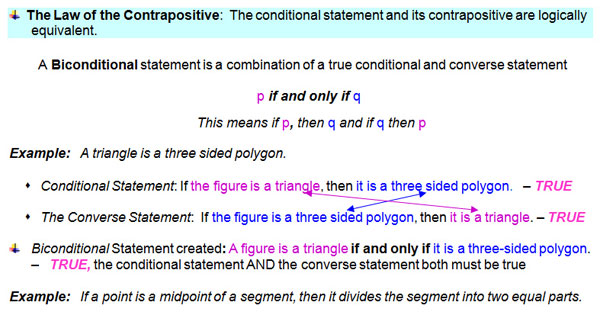![]() Watch the video for a quick review of Conditional, Converse, Inverse, and Contrapositive statements.
Watch the video for a quick review of Conditional, Converse, Inverse, and Contrapositive statements.
Source: Conditional, converse, inverse, contrapositive, Ludimachine, YoutTube
Logically equivalent statements have the same truth value.
Example:
Consider the following statements:
These are logically equivalent statements.
Example: (the example concerns only Austin, Texas)
Consider the following statements:
Which related conditional statements are logically equivalent?


![]() Drag each statement in blue below to the type of statement it is and decide whether it is true or false.
Drag each statement in blue below to the type of statement it is and decide whether it is true or false.
The table represents the results of the various combinations of the truth values for each conditional statement that can be formed based on the truth value of the Hypothesis and the Conclusion.

The Law of Detachment states that if p → q is true and p is true, then q is also true.
Example: If the measure of an angle is 90 degrees, then the angle is a right angle.

Is the conjecture valid (true)?
Hint:
| ✓ The conditional statement is true (the hypothesis (the measure of an angle is 90 degrees) and the conclusion (the angle is a right angle) are true). |
| ✓ The statement (the new hypothesis) is true. |
| ✓ According to the table, all the statements are true. Therefore, the conjecture is true by the Law of Detachment. |
Example: If a student is tardy 3 times, then he/she has to serve a lunch detention.
Is the conjecture valid (true)?
Hint:
| ✓ The conditional statement is true (a student is tardy three times and they serve lunch detention are both true.) |
| ✓ The statement "David is serving a lunch detention" matches the conclusion (a new conclusion). |
| ✓ According to the table, if the conclusion is true, the hypothesis is either true OR false. |
| ✓ Counter example: David could be in detention for any reason. Therefore, the conjecture is not valid. |
Click here for extra practice.